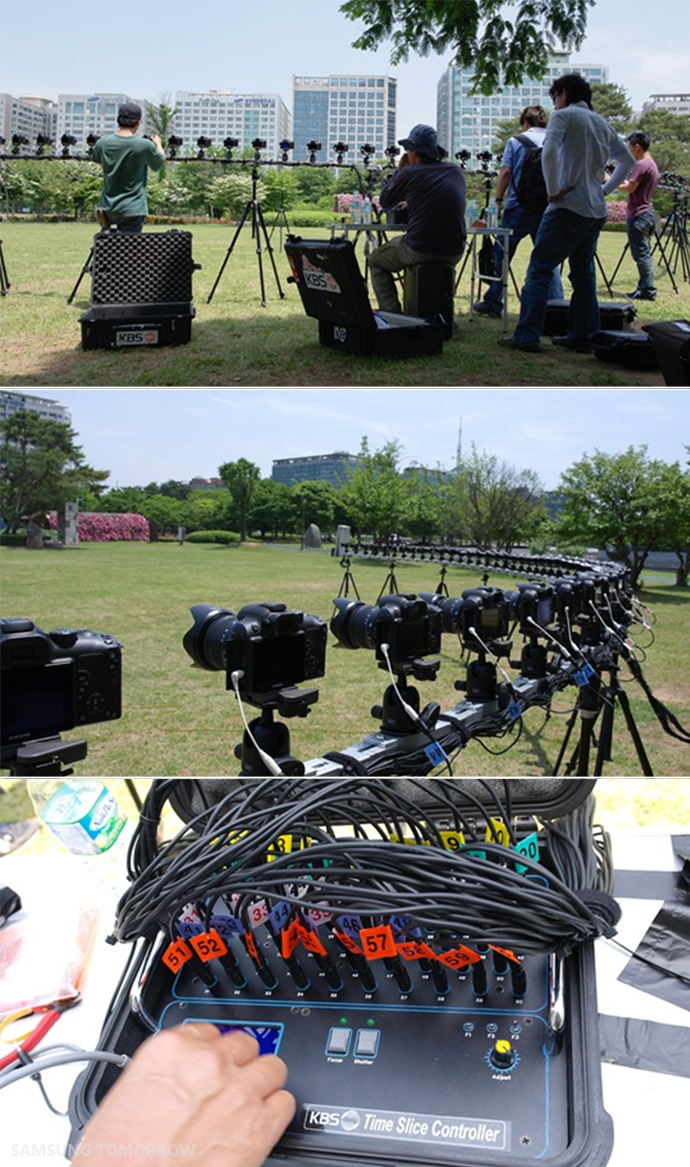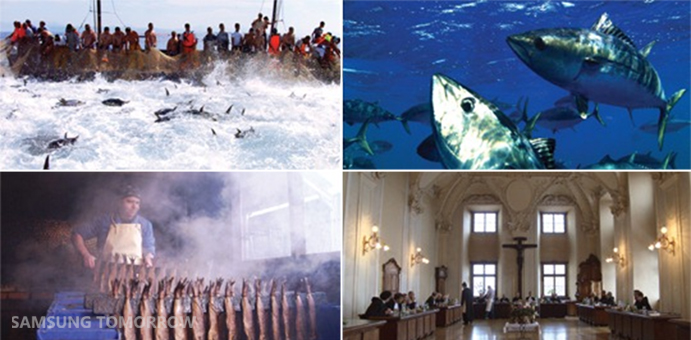Samsung NX cameras: ample opportunities for documentaries
“Super Fish” (Super Fish) is a historical documentary produced by the Korean TV and radio corporation KBS, which was produced using, guess what equipment? That's right: using Samsung NX cameras combined into one large system. Below you will find a story about cameras and shooting methods that have become an integral part of the production of a remarkable documentary.

Everyone remembers the famous effect of bullet time, which has become the hallmark of the “Matrix” trilogy. To create this effect, we used the technique of old art photography, known as “time slice” (time slice), which is as follows: around the object at a certain angle (in our case, the angle is 120 degrees) a large number of cameras are installed, which simultaneously shoot the object. As a result, the viewer sees the two-dimensional "pieces" of the three-dimensional moment, held together. This is reminiscent of how a person walks around a statue in order to get a better look at it from all sides.

')
In the photo above you can see how the film crew is testing time-sharing photography on the Samsung NX system before starting work. Shooting with time separation requires the installation of dozens, and sometimes hundreds of cameras, which takes a lot of time. The slight difference in the angle at which a particular camera is installed can create a big difference in the video, so the position of each camera should be as accurate as possible to ensure a full, seamless picture.

And this device simultaneously activates the shutter mechanisms on dozens of NX cameras at the same time. Even the smallest hitch in pressing the trigger would make the video unnatural, and the transitions from frame to frame - sharp, so the device to activate the camera shutters must be perfectly calibrated.
Let's take a look at the process of preparing and filming using this technology, and also learn a little more about the documentary film “Super Fish”.

The film "Super Fish" consists of five episodes: "Fish Planet" (Fish Planet), "The Great Taste of Fish" (Great Taste of Fish), "Mistery of Rotten Fish" (The Secret of Rotten Fish), "Fish on Friday" ( Fish on Friday) and Super Fish Diary (Diary of a Super Fish). Each episode allows viewers to enjoy the magnificence of nature in the most beautiful rivers and streams, oceans and deserts of the world.
In the first episode of “Fish Planet”, a story is being told about various fishing methods that have been transmitted from father to son for more than 100,000 years. The second episode of "The Great Taste of Fish" contains many recipes for cooking raw, salted, dried, fried and fermented fish. In Mistery of Rotten Fish, the creators of the documentary tape focused on dispelling all the myths and curiosities about rice and fish that go around East Asia. The fourth episode of “Fish on Friday” is an interesting story about fishing technologies and huge supplies of fish to medieval monasteries, as well as cultural prerequisites that led people to actively consume fish for food. The latest episode of “Super Fish Diary” was filmed in high-speed shooting mode, ultra-high-speed underwater shooting in HD format, and using the previously mentioned “time slice” technique.
To shoot a short video below, it took sixty Samsung NX cameras to be connected. The team unanimously believes that this day was one of the most difficult for the entire shooting period.

Everyone remembers the famous effect of bullet time, which has become the hallmark of the “Matrix” trilogy. To create this effect, we used the technique of old art photography, known as “time slice” (time slice), which is as follows: around the object at a certain angle (in our case, the angle is 120 degrees) a large number of cameras are installed, which simultaneously shoot the object. As a result, the viewer sees the two-dimensional "pieces" of the three-dimensional moment, held together. This is reminiscent of how a person walks around a statue in order to get a better look at it from all sides.

')
In the photo above you can see how the film crew is testing time-sharing photography on the Samsung NX system before starting work. Shooting with time separation requires the installation of dozens, and sometimes hundreds of cameras, which takes a lot of time. The slight difference in the angle at which a particular camera is installed can create a big difference in the video, so the position of each camera should be as accurate as possible to ensure a full, seamless picture.

And this device simultaneously activates the shutter mechanisms on dozens of NX cameras at the same time. Even the smallest hitch in pressing the trigger would make the video unnatural, and the transitions from frame to frame - sharp, so the device to activate the camera shutters must be perfectly calibrated.
Let's take a look at the process of preparing and filming using this technology, and also learn a little more about the documentary film “Super Fish”.

The film "Super Fish" consists of five episodes: "Fish Planet" (Fish Planet), "The Great Taste of Fish" (Great Taste of Fish), "Mistery of Rotten Fish" (The Secret of Rotten Fish), "Fish on Friday" ( Fish on Friday) and Super Fish Diary (Diary of a Super Fish). Each episode allows viewers to enjoy the magnificence of nature in the most beautiful rivers and streams, oceans and deserts of the world.
In the first episode of “Fish Planet”, a story is being told about various fishing methods that have been transmitted from father to son for more than 100,000 years. The second episode of "The Great Taste of Fish" contains many recipes for cooking raw, salted, dried, fried and fermented fish. In Mistery of Rotten Fish, the creators of the documentary tape focused on dispelling all the myths and curiosities about rice and fish that go around East Asia. The fourth episode of “Fish on Friday” is an interesting story about fishing technologies and huge supplies of fish to medieval monasteries, as well as cultural prerequisites that led people to actively consume fish for food. The latest episode of “Super Fish Diary” was filmed in high-speed shooting mode, ultra-high-speed underwater shooting in HD format, and using the previously mentioned “time slice” technique.
To shoot a short video below, it took sixty Samsung NX cameras to be connected. The team unanimously believes that this day was one of the most difficult for the entire shooting period.
Source: https://habr.com/ru/post/161497/
All Articles